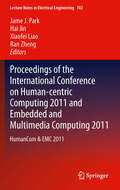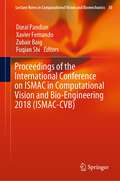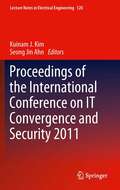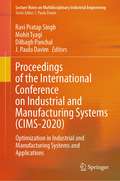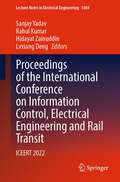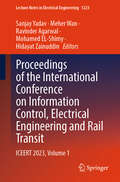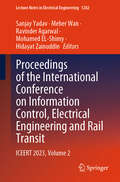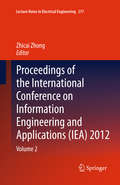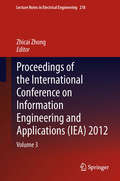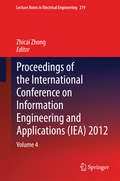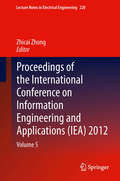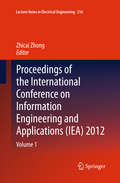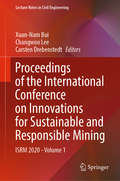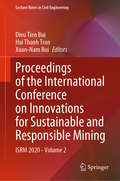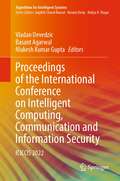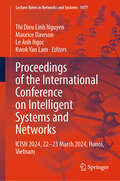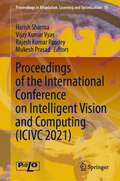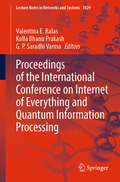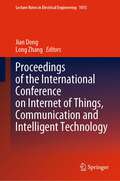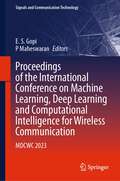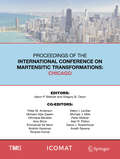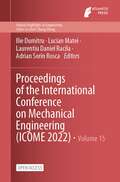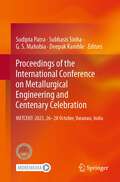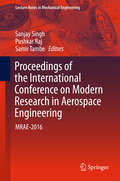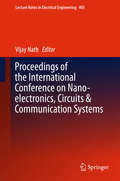- Table View
- List View
Proceedings of the International Conference on Human-centric Computing 2011 and Embedded and Multimedia Computing 2011
by Hai Jin Xiaofei Liao James J. Park Ran ZhengProceedings of the International Conference on Human-centric Computing and Embedded and Multimedia Computing (HumanCom & EMC 2011) will cover topics of HumanCom and EMC, the current hot topics satisfying the world-wide ever-changing needs. Human-centric computing is to create novel solutions so that the humans are always connected, portable, and available. As with pervasive-computing, human-centric computing requires a variety of devices; however, such devices exist simply to obtain inputs from the human and are embedded in objects that humans interact with on a daily basis. Moreover, during the past couple of decades, Information Science technologies influenced and changed every aspect of our lives and our cultures. Without various Information Science technology-based applications, it would be difficult to keep information stored securely, to process information efficiently, and to communicate conveniently. Embedded computing ranges from portable devices such as digital watches and MP3 players, to large stationary installations like traffic lights, factory controllers, or the systems controlling nuclear power plants. Complexity varies from low, with a single microcontroller chip, to very high with multiple units, peripherals and networks mounted inside a large chassis or enclosure. Multimedia computing covers multimedia I/O devices, OS, storage systems, streaming media middleware, continuous media representations, media coding, media processing, etc., and also includes multimedia communications; real-time protocols, end-to-end streaming media, resource allocation, multicast protocols, and multimedia applications; databases, distributed collaboration, video conferencing, 3D virtual environments.
Proceedings of the International Conference on ISMAC in Computational Vision and Bio-Engineering 2018 (Lecture Notes in Computational Vision and Biomechanics #30)
by Xavier Fernando Durai Pandian Zubair Baig Fuqian ShiThese are the proceedings of the International Conference on ISMAC-CVB, held in Palladam, India, in May 2018. The book focuses on research to design new analysis paradigms and computational solutions for quantification of information provided by object recognition, scene understanding of computer vision and different algorithms like convolutional neural networks to allow computers to recognize and detect objects in images with unprecedented accuracy and to even understand the relationships between them. <P><P>The proceedings treat the convergence of ISMAC in Computational Vision and Bioengineering technology and includes ideas and techniques like 3D sensing, human visual perception, scene understanding, human motion detection and analysis, visualization and graphical data presentation and a very wide range of sensor modalities in terms of surveillance, wearable applications, home automation etc. <P><P>ISMAC-CVB is a forum for leading academic scientists, researchers and research scholars to exchange and share their experiences and research results about all aspects of computational vision and bioengineering.
Proceedings of the International Conference on IT Convergence and Security 2011
by Kuinam J. Kim Seong Jin AhnAs we entered the 21st century, the rapid growth of information technology has changed our lives more conveniently than we have ever speculated. Recently in all fields of the industry, heterogeneous technologies have converged with information technology resulting in a new paradigm, information technology convergence. In the process of information technology convergence, the latest issues in the structure of data, system, network, and infrastructure have become the most challenging task. Proceedings of the International Conference on IT Convergence and Security 2011 approaches the subject matter with problems in technical convergence and convergences of security technology by looking at new issues that arise from techniques converging. The general scope is convergence security and the latest information technology with the following most important features and benefits: 1. Introduction of the most recent information technology and its related ideas 2. Applications and problems related to technology convergence, and its case studies 3. Introduction of converging existing security techniques through convergence security Overall, after reading Proceedings of the International Conference on IT Convergence and Security 2011, readers will understand the most state of the art information strategies and technologies of convergence security.
Proceedings of the International Conference on Industrial and Manufacturing Systems: Optimization in Industrial and Manufacturing Systems and Applications (Lecture Notes on Multidisciplinary Industrial Engineering)
by J. Paulo Davim Mohit Tyagi Dilbagh Panchal Ravi Pratap SinghIn order to deal with the societal challenges novel technology plays an important role. For the advancement of technology, Department of Industrial and Production Engineering under the aegis of NIT Jalandhar is organizing an “International Conference on Industrial and Manufacturing Systems” (CIMS-2020) from 26th -28th June, 2020. The present conference aims at providing a leading forum for sharing original research contributions and real-world developments in the field of Industrial and Manufacturing Systems so as to contribute its share for technological advancements. This volume encloses various manuscripts having its roots in the core of industrial and production engineering. Globalization provides all around development and this development is impossible without technological contributions. CIMS-2020, gathered the spirits of various academicians, researchers, scientists and practitioners, answering the vivid issues related to optimisation in the various problems of industrial and manufacturing systems.
Proceedings of the International Conference on Information Control, Electrical Engineering and Rail Transit: ICEERT 2022 (Lecture Notes in Electrical Engineering #1084)
by Rahul Kumar Sanjay Yadav Hidayat Zainuddin Lvxiang DengThis book includes the peer-reviewed proceedings of the 2nd International Conference on Information Control, Electrical Engineering, and Rail Transit (ICEERT 2022). This book provides the advanced research results of transportation and covers the main research fields of information control, traffic information engineering, and control, intelligent transit, logistics, etc. This book aims to promote a new green and intelligent mode of rail transit between scholars from the top universities, research centers, and high-tech enterprises around the world, which is beneficial to researchers and practitioners in mechanical engineering.
Proceedings of the International Conference on Information Control, Electrical Engineering and Rail Transit: ICEERT 2023, Volume 1 (Lecture Notes in Electrical Engineering #1223)
by Sanjay Yadav Meher Wan Hidayat Zainuddin Ravinder Agarwal Mohamed El-ShimyThis book includes the peer-reviewed proceedings of the 3rd International Conference on Information Control, Electrical Engineering, and Rail Transit (ICEERT 2023). This book provides the advanced research results of transportation and covers the main research fields of information control, traffic information engineering, and control, intelligent transit, logistics, etc. This book aims to promote a new green and intelligent mode of rail transit between scholars from the top universities, research centers, and high-tech enterprises around the world, which is beneficial to researchers and practitioners in mechanical engineering.
Proceedings of the International Conference on Information Control, Electrical Engineering and Rail Transit: ICEERT 2023, Volume 2 (Lecture Notes in Electrical Engineering #1282)
by Sanjay Yadav Meher Wan Hidayat Zainuddin Ravinder Agarwal Mohamed El-ShimyThis book includes the peer-reviewed proceedings of the 3rd International Conference on Information Control, Electrical Engineering, and Rail Transit (ICEERT 2023). This book provides the advanced research results of transportation and covers the main research fields of information control, traffic information engineering, and control, intelligent transit, logistics, etc. This book aims to promote a new green and intelligent mode of rail transit between scholars from the top universities, research centers, and high-tech enterprises around the world, which is beneficial to researchers and practitioners in mechanical engineering.
Proceedings of the International Conference on Information Engineering and Applications (IEA) 2012: 217
by Zhicai ZhongInformation engineering and applications is the field of study concerned with constructing information computing, intelligent systems, mathematical models, numerical solution techniques, and using computers and other electronic devices to analyze and solve natural scientific, social scientific and engineering problems. <P><P> Information engineering is an important underpinning for techniques used in information and computational science and there are many unresolved problems worth studying. The Proceedings of the 2nd International Conference on Information Engineering and Applications (IEA 2012), which was held in Chongqing, China, from October 26-28, 2012, discusses the most innovative research and developments including technical challenges and social, legal, political, and economic issues.<P> A forum for engineers and scientists in academia, industry, and government, the Proceedings of the 2nd International Conference on Information Engineering and Applications presents ideas, results, works in progress, and experience in all aspects of information engineering and applications.
Proceedings of the International Conference on Information Engineering and Applications (IEA) 2012: 218
by Zhicai ZhongInformation engineering and applications is the field of study concerned with constructing information computing, intelligent systems, mathematical models, numerical solution techniques, and using computers and other electronic devices to analyze and solve natural scientific, social scientific and engineering problems. <P><P> Information engineering is an important underpinning for techniques used in information and computational science and there are many unresolved problems worth studying. The Proceedings of the 2nd International Conference on Information Engineering and Applications (IEA 2012), which was held in Chongqing, China, from October 26-28, 2012, discusses the most innovative research and developments including technical challenges and social, legal, political, and economic issues.<P> A forum for engineers and scientists in academia, industry, and government, the Proceedings of the 2nd International Conference on Information Engineering and Applications presents ideas, results, works in progress, and experience in all aspects of information engineering and applications.
Proceedings of the International Conference on Information Engineering and Applications (IEA) 2012: 219
by Zhicai ZhongInformation engineering and applications is the field of study concerned with constructing information computing, intelligent systems, mathematical models, numerical solution techniques, and using computers and other electronic devices to analyze and solve natural scientific, social scientific and engineering problems. <P><P> Information engineering is an important underpinning for techniques used in information and computational science and there are many unresolved problems worth studying. The Proceedings of the 2nd International Conference on Information Engineering and Applications (IEA 2012), which was held in Chongqing, China, from October 26-28, 2012, discusses the most innovative research and developments including technical challenges and social, legal, political, and economic issues.<P> A forum for engineers and scientists in academia, industry, and government, the Proceedings of the 2nd International Conference on Information Engineering and Applications presents ideas, results, works in progress, and experience in all aspects of information engineering and applications.
Proceedings of the International Conference on Information Engineering and Applications (IEA) 2012: 220
by Zhicai ZhongInformation engineering and applications is the field of study concerned with constructing information computing, intelligent systems, mathematical models, numerical solution techniques, and using computers and other electronic devices to analyze and solve natural scientific, social scientific and engineering problems. <P><P> Information engineering is an important underpinning for techniques used in information and computational science and there are many unresolved problems worth studying. The Proceedings of the 2nd International Conference on Information Engineering and Applications (IEA 2012), which was held in Chongqing, China, from October 26-28, 2012, discusses the most innovative research and developments including technical challenges and social, legal, political, and economic issues.<P> A forum for engineers and scientists in academia, industry, and government, the Proceedings of the 2nd International Conference on Information Engineering and Applications presents ideas, results, works in progress, and experience in all aspects of information engineering and applications.
Proceedings of the International Conference on Information Engineering and Applications (IEA) 2012: Volume 1
by Zhicai ZhongInformation engineering and applications is the field of study concerned with constructing information computing, intelligent systems, mathematical models, numerical solution techniques, and using computers and other electronic devices to analyze and solve natural scientific, social scientific and engineering problems. <P><P> Information engineering is an important underpinning for techniques used in information and computational science and there are many unresolved problems worth studying. The Proceedings of the 2nd International Conference on Information Engineering and Applications (IEA 2012), which was held in Chongqing, China, from October 26-28, 2012, discusses the most innovative research and developments including technical challenges and social, legal, political, and economic issues.<P> A forum for engineers and scientists in academia, industry, and government, the Proceedings of the 2nd International Conference on Information Engineering and Applications presents ideas, results, works in progress, and experience in all aspects of information engineering and applications.
Proceedings of the International Conference on Innovations for Sustainable and Responsible Mining: ISRM 2020 - Volume 1 (Lecture Notes in Civil Engineering #109)
by Carsten Drebenstedt Xuan-Nam Bui Changwoo LeeThis volume gathers the latest advances, innovations, and applications in the field of mining, geology and geo-spatial technologies, as presented by leading researchers and engineers at the International Conference on Innovations for Sustainable and Responsible Mining (ISRM), held in Hanoi, Vietnam on October 15-17 2020. The contributions cover a diverse range of topics, including mining technology, drilling and blasting engineering, tunneling and geotechnical applications, mineral processing, mine management and economy, environmental risk assessment and management, mining and local development, mined land rehabilitation, water management and hydrogeology, regional Geology and tectonics, spatial engineering for monitoring natural resources and environment change, GIS and remote sensing for natural disaster monitoring, risk mapping and revisualization, natural resources monitoring and management, mine occupational safety and health. Selected by means of a rigorous peer-review process, they will spur novel research directions and foster future multidisciplinary collaborations.
Proceedings of the International Conference on Innovations for Sustainable and Responsible Mining: ISRM 2020 - Volume 2 (Lecture Notes in Civil Engineering #108)
by Dieu Tien Bui Hai Thanh Tran Xuan-Nam BuiThis volume gathers the latest advances, innovations, and applications in the field of mining, geology and geo-spatial technologies, as presented by leading researchers and engineers at the International Conference on Innovations for Sustainable and Responsible Mining (ISRM), held in Hanoi, Vietnam on October 15-17 2020. The contributions cover a diverse range of topics, including mining technology, drilling and blasting engineering, tunneling and geotechnical applications, mineral processing, mine management and economy, environmental risk assessment and management, mining and local development, mined land rehabilitation, water management and hydrogeology, regional Geology and tectonics, spatial engineering for monitoring natural resources and environment change, GIS and remote sensing for natural disaster monitoring, risk mapping and revisualization, natural resources monitoring and management, mine occupational safety and health. Selected by means of a rigorous peer-review process, they will spur novel research directions and foster future multidisciplinary collaborations.
Proceedings of the International Conference on Intelligent Computing, Communication and Information Security: ICICCIS 2022 (Algorithms for Intelligent Systems)
by Basant Agarwal Mukesh Kumar Gupta Vladan DevedzicThis book contains high quality research papers accepted and presented at the International Conference on Intelligent Computing, Communication and Information Security (ICICCIS 2022), organized by Swami Keshvanand Institute of Technology, Management & Gramothan (SKIT), Jaipur, India during 25-26, November 2022. It presents the solutions of issues and challenges in intelligent computing, communication and information security domains. This book provides a background to problem domains, considering the progress so far, assessing the potential of such approaches, and exploring possible future directions as a single readily accessible source.
Proceedings of the International Conference on Intelligent Systems and Networks: ICISN 2024, 22-23 March 2024, Hanoi, Vietnam (Lecture Notes in Networks and Systems #1077)
by Kwok Yan Lam Thi Dieu Linh Nguyen Le Anh Ngoc Maurice DawsonThis book presents Proceedings of the International Conference on Intelligent Systems and Networks, Hanoi, Vietnam, a collection of peer-reviewed articles accepted by ICISN 2024. It includes current research outcomes and results of cutting-edge work reported by the authors. The articles included here are very useful for researchers and industry practitioners. The scope of the proceedings include, but not limited to Foundations of Computer Science; Computational Intelligence, Language and speech processing; Software Engineering and software development methods; Wireless Communications, Signal Processing for Communications, Next-generation mobile networks, Internet-of-Things and Sensor Systems; etc. In all, this proceedings is of great value as reference in these emerging areas of research.
Proceedings of the International Conference on Intelligent Vision and Computing (Proceedings in Adaptation, Learning and Optimization #15)
by Harish Sharma Mukesh Prasad Vijay Kumar Vyas Rajesh Kumar PandeyThis book gathers outstanding research papers presented at the International Conference on Intelligent Vision and Computing (ICIVC 2021), held online during October 03–04, 2021. ICIVC 2021 is organised by Sur University, Oman. The book presents novel contributions in intelligent vision and computing and serves as reference material for beginners and advanced research. The topics covered are intelligent systems, intelligent data analytics and computing, intelligent vision and applications collective intelligence, soft computing, optimization, cloud computing, machine learning, intelligent software, robotics, data science, data security, big data analytics, and signal natural language processing.
Proceedings of the International Conference on Internet of Everything and Quantum Information Processing (Lecture Notes in Networks and Systems #1029)
by Valentina E. Balas Kolla Bhanu Prakash G. P. Saradhi VarmaThis book constitutes the Proceedings of the International Conference on Internet of Everything and Quantum Information Processing (IEQIP-2023), held on 24–25 November 2023 in Andhra Pradesh, India. This edition was organized in hybrid mode by the Department of Computer Science and Engineering, Koneru Lakshmaiah Education Foundation, and sponsored by the Department of Science and Technology, India. The Internet of Things (IoT) and Quantum Computing are technological phenomena that are shaping businesses and industries. Moreover, integrating IoT and Quantum Computing solutions evolves ecosystems to offer optimum commercial practices. The emergence of these two phenomena offers revolutionary advancements. Further, Quantum Computing introduces avant-garde encryption algorithms for resilient security solutions in IoT systems. Papers presented at this conference showed how the Internet of Everything (IoE) combines sensing, computation, information extraction, and communication functionalities together in a device. IoE allows different electronic devices with different capabilities to sense the environment and to communicate for data exchange. Further, the challenge now is to identify, monitor, and ensure quality in IoT security. Moreover, there is a significant rise in data and information transfer due to a rise in the number of devices. Hence, there is a requirement for responsive, scalable, analytical, and efficient solutions. The conference papers included in this book contain topics in the following areas of research: · Artificial Intelligence · Quantum Computing · Internet of Things, Cloud Computing, and Data Science · Machine learning · Deep learning · Image, text, and signal processing · Disruptive technologies. This book provides helpful information to professors, researchers, and graduate students in the area of Quantum Computing and IoT, and all find this collection of papers inspiring, informative, and valuable.
Proceedings of the International Conference on Internet of Things, Communication and Intelligent Technology (Lecture Notes in Electrical Engineering #1015)
by Long Zhang Jian DongThis book includes original, peer-reviewed research papers from the International Conference on Internet of Things, Communication and Intelligent Technology (IoTCIT) 2022. It contains the application of communication and IoT engineering in the age of intelligent technology+ from the standpoint of disciplinary integration, combining theory and associated IoT and intelligent technology algorithms. The topics cover the full range of IoT solutions, from IoT to network security, and focus on many forms of communication, such as Next Generation (6G) Mobile Communication, D2D, and M2M Communication. Additionally, it examines Intelligent Technology, with a focus on Information System Modeling and Simulation. It also explores Cloud Computing, Pervasive and Mobile Computing, Distributed Computing, High Performance Computing, and Ubiquitous Computing.
Proceedings of the International Conference on Machine Learning, Deep Learning and Computational Intelligence for Wireless Communication: MDCWC 2023 (Signals and Communication Technology)
by E. S. Gopi P MaheswaranThis book is a collection of best selected research papers presented at the 2nd Conference on Machine Learning, Deep Learning and Computational Intelligence for Wireless Communication (MDCWC 2023) held during June 22-24th, 2023, at the National Institute of Technology Tiruchirappalli, India. The presented papers are grouped under the following topics (a) Machine learning, Deep learning and Computational intelligence algorithms (b) Wireless communication systems and (c) Mobile data applications. The topics include the latest research and results in the areas of network prediction, traffic classification, call detail record mining, mobile health care, mobile pattern recognition, natural language processing, automatic speech processing, mobility analysis, indoor localization, wireless sensor networks (WSN), energy minimization, routing, scheduling, resource allocation, multiple access, power control, malware detection, cyber security, flooding attacks detection, mobile apps sniffing, MIMO detection, signal detection in MIMO-OFDM, modulation recognition, channel estimation, MIMO nonlinear equalization, super-resolution channel and direction-of-arrival estimation. The book is a rich reference material for academia and industry.
Proceedings of the International Conference on Martensitic Transformations: Chicago
by Aaron P. Stebner Gregory B. OlsonThis collection is organized around the central theme of “Martensite by Design.” Contributions include design, microstructure, properties, advanced processing and manufacturing, performance, phase transformations, and characterization.
Proceedings of the International Conference on Mechanical Engineering (Atlantis Highlights in Engineering #15)
by Ilie Dumitru Lucian Matei Laurentiu Daniel Racila Adrian Sorin RoscaThis is an open access book.Faculty of Mechanics is organizing International Conference of Mechanical Engineering, ICOME 2022 that will be held on 18th–20th of May 2022.The aim of the conference is to provide opportunities for the participants to:Gain insight into the cutting-edge technologies and ideas for future developments;Update their skills and knowledge by attending focused technical sessions;Network with potential new partners, clients and suppliers;View the latest technology products and services in the technical exhibition.The conference aims to bring together scientists, engineers, manufacturers and users from all over the world to discuss common theoretical and practical problems, describe scientific applications and explore avenues for the future researches in the area of Mechanical engineering.
Proceedings of the International Conference on Metallurgical Engineering and Centenary Celebration: METCENT-2023, 26-28 October, Varanasi, India
by Sudipta Patra Subhasis Sinha G. S. Mahobia Deepak KambleThis book presents peer reviewed articles from The International Conference on Metallurgical Engineering and Centenary Celebration (METCENT 2023), held at Indian Institute of Technology (BHU) Varanasi, India from the 26-28th of October 2023. It covers wide areas of metallurgical and materials science, highlighting recent advancements in these areas, including but not limited to Advanced Steels, Computational Material Science, Recent Ferrous/Non-Ferrous Metallurgy Processes, Green Iron and Steel Making Technologies and others. METCENT 2023 provides a unique opportunity to all the Metallurgists, Materials Scientists, Academicians and Industry experts to share their experiences on this special occasion.
Proceedings of the International Conference on Modern Research in Aerospace Engineering
by Sanjay Singh Pushkar Raj Samir TambeThis book includes high-quality research papers presenting the latest advances in aerospace and related engineering fields. The papers are organized according to six broad areas (i) Aerospace Propulsion, (ii) Space Research, Avionics and Instrumentation, (iii) Aerodynamics Wind Tunnel and Computational fluid dynamics (CFD), (iv) Structural Analysis and Finite Element Method (FEM), (v) Materials, Manufacturing and Air Safety and (vi) Aircraft Environmental and Control System and Stability, making it easy for readers to find the information they require. Offering insights into the state of the art in aerospace engineering, the original research presented is valuable to academics, researchers, undergraduate and postgraduate students as well as professionals in industry and R&D. The clearly written book can be used for the validation of data, and the development of experimental and simulation techniques as well as other mathematical approaches.
Proceedings of the International Conference on Nano-electronics, Circuits & Communication Systems
by Vijay NathThis volume comprises select papers from the International Conference on Nano-electronics, Circuits & Communication Systems(NCCS). The conference focused on the frontier issues and their applications in business, academia, industry, and other allied areas. This international conference aimed to bring together scientists, researchers, engineers from academia and industry. The book covers technological developments and current trends in key areas such as VLSI design, IC manufacturing, and applications such as communications, ICT, and hybrid electronics. The contents of this volume will prove useful to researchers, professionals, and students alike.
